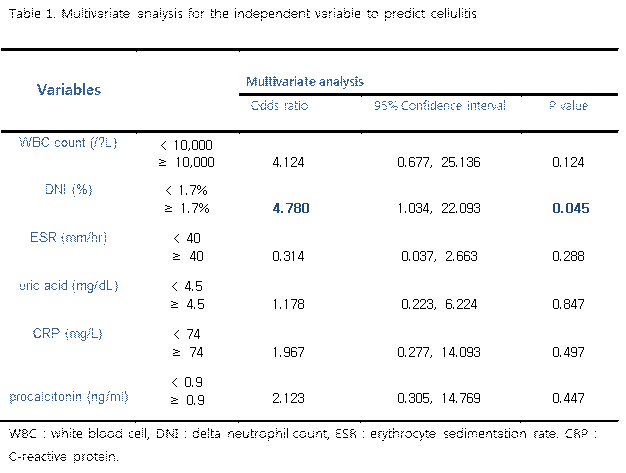Session Information
Session Type: ACR Poster Session A
Session Time: 9:00AM-11:00AM
Background/Purpose:
Diagnosis of a patient who comes with acute foot
pain is often challenging, because both acute gouty arthritis and cellulitis
share common clinical manifestations such as redness, warmth, tenderness and
soft tissue swelling, and inflammatory markers do not discriminate between
those two entities. When it comes to patients with normouricemia, it is
even more challenging. Differentiating acute gouty arthritis from cellulitis is
critical for deciding treatment strategies, which will prevent the misuse of
antibiotics for gout and prevent a delay of antibiotics treatment for
cellulitis.
Delta neutrophil index (DNI) is a difference
between leukocyte subfractions which corresponds to the fraction of
immature granulocyte. DNI was reported to be associated with infection and
sepsis, therefore it is considered to be helpful in differentiating acute gouty
arthritis and cellulitis.
In this study, we evaluated the utility of DNI
as a predictive marker in differentiating acute gouty arthritis and cellulitis
in normouricemic patients.
Methods:
We reviewed medical records of total
212 normouricemic patients who were admitted from January 2011 to
April 2015. 74 patients had acute gouty arthritis and 138 patients were
diagnosed cellulitis of lower limbs, and all the patients had serum uric acid
below 7 mg/dL. DNI was automatically determined by the ADVIA 2120 electronic
cell analyzer. Multivariate logistic regression was used to find independent
variables for predicting cellulitis among variables which had statistical
differences in chai-square test or which had clinical implication. Cutoff for
categorizing values were determined by receiver operating characteristic (ROC)
curve.
Results:
The cellulitis group showed higher levels of
white blood cell counts, CRP and lower levels of uric acid. ESR
and procalcitonin had no difference between two groups. Patients in
acute gouty arthritis group had significant lower values of DNI than those in
cellulitis group (0.7 ± 0.9
% vs 2.6 ± 3.1 %, p<0.0001).
In multivariate logistic regression analysis, DNI was the only significant
independent factor for discriminating cellulitis from acute gouty arthritis.
When we selected DNI value of 1.7% as the cutoff for cellulitis, patients with
DNI 1.7% or higher were found to have higher risk for cellulitis than
those with DNI less than 1.7% (Odds
ratio 4.780).
Conclusion:
The present study seems to be the first to
evaluate DNI in gout investigating its usefulness as a novel serologic marker
for differentiating acute gouty arthritis from cellulitis. Our findings
demonstrate that DNI measurement is useful for predicting cellulitis superior
to ESR, CRP or procalcitonin in normouricemic patients and
helpful in making decisions about the treatment.
To cite this abstract in AMA style:
Pyo JY, Song JJ, Park YB, Lee SK, Lee SW. Serum Delta Neutrophil Index Measurement for Differentiating Acute Gouty Arthritis and Cellulitis in Normouricemic Patients [abstract]. Arthritis Rheumatol. 2015; 67 (suppl 10). https://acrabstracts.org/abstract/serum-delta-neutrophil-index-measurement-for-differentiating-acute-gouty-arthritis-and-cellulitis-in-normouricemic-patients/. Accessed .« Back to 2015 ACR/ARHP Annual Meeting
ACR Meeting Abstracts - https://acrabstracts.org/abstract/serum-delta-neutrophil-index-measurement-for-differentiating-acute-gouty-arthritis-and-cellulitis-in-normouricemic-patients/

